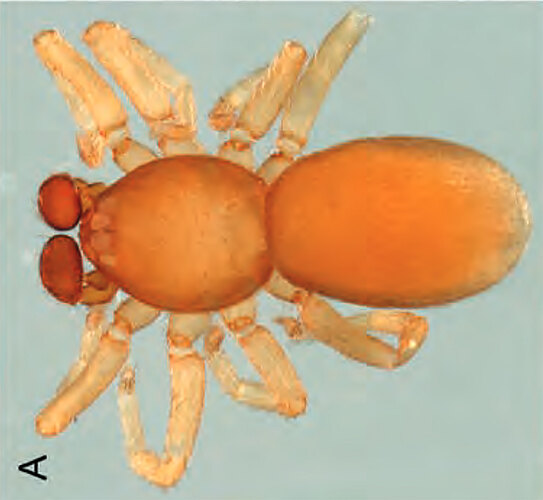Johanna's Goblin Spider Opopaea johannae Baehr & Harvey, 2013
Fauna Portal species: 250Diagnosis
(after Baehr et al. 2013): Males and females of Opopaea johannae resemble those of O. millstream in general body shape, having a finely reticulated carapace, scuto-pedicel region less than diameter of pedicel and paired scutal ridges short, not connected. In males the patella connection to femur at anterior half and the broad complex folded bulbal tip are also similar, but they can be distinguished by the triangular medially directed prolateral extension close to palpal tip. In females the epigastic fold (EF) posterior margin is slightly bowed with median triangle.
Within the context of the oonopid fauna of Barrow Island, O. johannae is most similar to O. callani and O. harmsi due to the elongated abdomen. Opopaea johannae is less shiny than O. callani and the sternum does not protrude as far posteriorly. Males of O. johannae are best differentiated from thos of O. harmsi by the distinctly terminally 'lapped' pedipalp, which is much narroer in O. harmsi.
Status
- native
Linnean Holotype
Australia
- Western Australia
Fauna Portal Records
The map shows all records that have been verified as part of the Fauna Portal project and may not represent the true distribution of a species. Specifically, for described species, check the link to the Atlas of Living Australia on this page for potential wider distributions. Fauna Portal Reference specimens and Linnean types are shown in red. If you identified a specimen that exceeds the distribution of an undescribed species as illustrated here, please contact the Fauna Portal team who can assist with the lodgement of the specimen in a public institution and display on the map.
Publications
Baehr BC, Harvey MS, Smith HM, Ott R (2013): The goblin spider genus Opopaea in Australia and the Pacific islands (Araneae: Oonopidae). Memoirs of the Queensland Museum - Nature. 58: 107 - 338
Araneae (Spiders)
- Actinopodidae
- Anamidae
- Araneae fam. indet.
- Araneidae
- Archaeidae
- Argyronetidae
- Arkyidae
- Barychelidae
- Cheiracanthiidae
- Clubionidae
- Corinnidae
- Cycloctenidae
- Deinopidae
- Desidae
- Dictynidae
- Filistatidae
- Gnaphosidae
- Halonoproctidae
- Hersiliidae
- Idiopidae
- Lamponidae
- Linyphiidae
- Lycosidae
- Mimetidae
- Miturgidae
- Mysmenidae
- Nicodamidae
- Oecobiidae
- Oonopidae
- Oxyopidae
- Philodromidae
- Pholcidae
- Pisauridae
- Prodidomidae
- Salticidae
- Scytodidae
- Segestriidae
- Selenopidae
- Sparassidae
- Symphytognathidae
- Tetrablemmidae
- Tetragnathidae
- Theridiidae
- Thomisidae
- Trachelidae
- Trachycosmidae
- Trochanteriidae
- Uloboridae
- Zodariidae
- Zoropsidae
All classes
- Arachnida
- Crustacea
- Entognatha
- Gastropoda
- Insecta
- Orthoptera - Caelifera (Grasshoppers)
- Hymenoptera excl. Formicidae (bees and wasps)
- Blattodea s. str. (Cockroaches)
- Coleoptera (Beetles)
- Dermaptera (earwigs)
- Diptera (flies, mosquitos)
- Entomobryomorpha (slender springtails)
- Hemiptera - Heteroptera (True Bugs)
- Hemiptera - Sternorrhyncha (aphids, scales etc.)
- Hemiptera - Auchenorrhyncha (cicadas, planthoppers)
- Hymenoptera - Formicidae (Ants)
- Trichoptera (Caddisflies)
- Zygentoma (silverfish)
- Myriapoda

